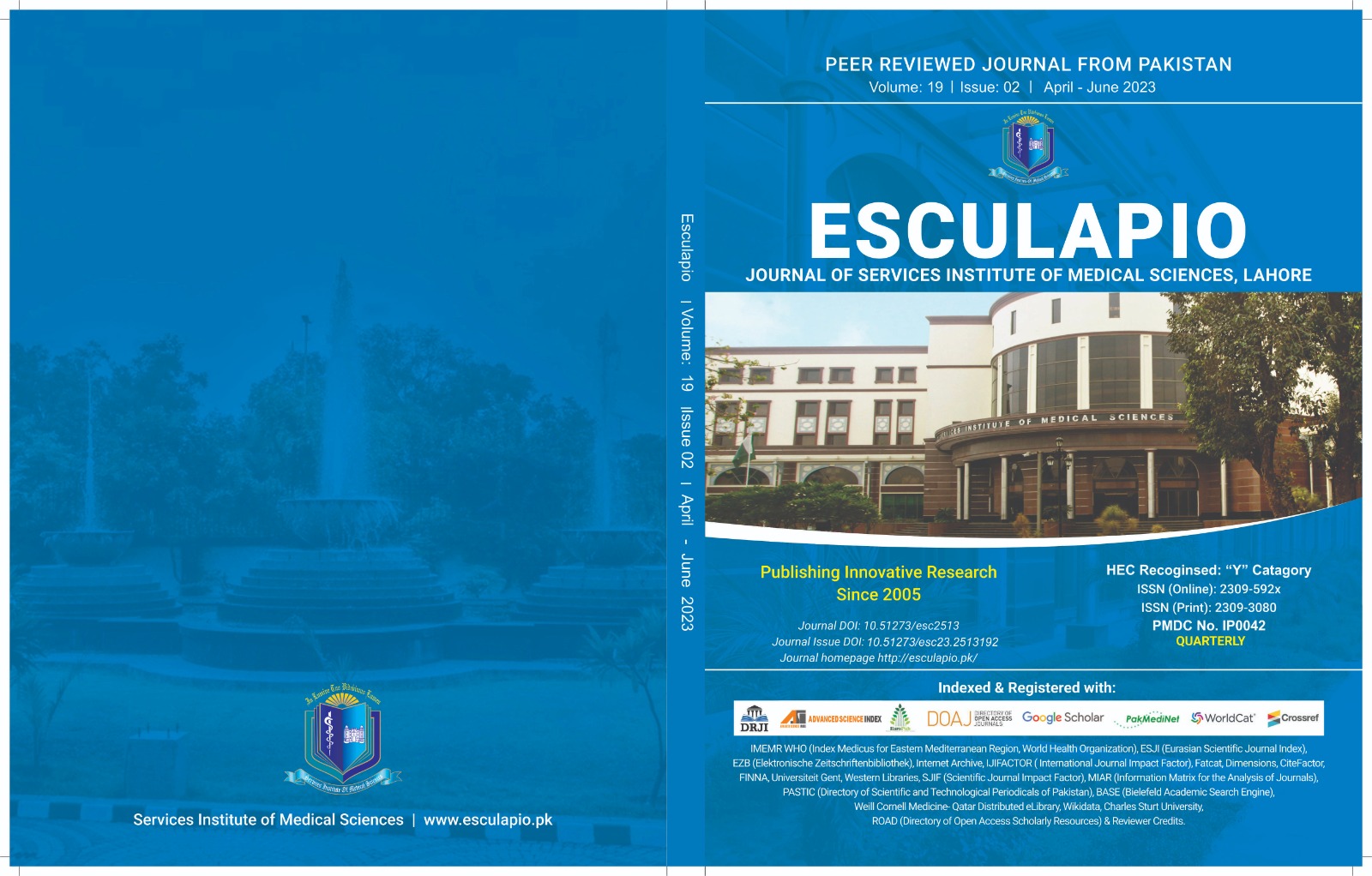Neutrophil to Lymphocyte Ratio As A Predictor of Endoscopic Damage in Caustic Injuries
DOI:
https://doi.org/10.51273/esc23.251928Keywords:
Caustic injury, NLR, Zargar classificationAbstract
Objective: To assess the ingestion of caustic substances is a medical emergency and esophagogastroduodenoscopy (EGD) is helpful in diagnosis, prognostication and management. Here, we investigated the NLR of patients, to assess the correlation of neutrophil lymphocyte ratio (NLR) with degree of caustic injury and to evaluate whether NLR can predict the degree of caustic endoscopic injury.
Method: This cross sectional study was carried out on 180 patients in gastroenterology department of DHQ teaching hospital, Gujranwala from 1st Jan 2021 to 31 Dec 2021. The endoscopy was performed and CBC
was sent for analysis of NLR. The esophageal and stomach mucosal injury was graded by Zargar's classification and divided into low grade and high grade. Independent sample t test was used for comparison between mean NLR versus low and high grade injury.
Results: Patients with high grade damage has remarkably higher values of NLR as compared to low grade. For prediction of grade of damage, ROC analysis was used and AUC (area under curve) value was 0.838 (95% CI (0.783-0.894, p<0.001) and if we take NLR cut-off value as 3.5, the sensitivity will be 96.0% and specificity 63.3%, if we take cut-off value as 4.5, the sensitivity will be 93.1% and specificity 48.1% and if we take cut-off value as 5.5, the sensitivity will be 75.2% and specificity 35.4%.
Conclusion: Neutrophil to lymphocyte ratio can predict degree of gastroesophageal injury in patients with caustic ingestion.
References
MahmoudvandZ,ShanbehzadehM,ShafieeM,KazemiArpanahi H. Developing the minimum data set of the corrosive ingestion registry system in Iran.BMC Health Serv Res. 2022 Sep 27;22(1):1207
Methasate A and Lohsiriwat V. Role of endoscopy in caustic injury of the esophagus. World J Gastrointest Endosc 2018 October 16; 10(10): 274-282.
De Lusong MAA, TimbolABG, Tuazon DJS. Management of esophageal caustic injury.World J Gastrointest Pharmacol Ther. 2017 May 6; 8(2):90-98.
HallAH,Jacquemin D, Henny D, Mathieu L,Josset P, Meyer B. Corrosive substances ingestion: a review. Crit Rev Toxicol. 2019 Sep;49(8):637-669.
ChenYJ,SeakCJ,KangSC,ChenTH,ChenCC,NgCJ, Lee CW, Su MY, Huang HC, Chen PC, Ooyang CH, Hsieh SY, Cheng HT. Anew perspective of the risk of caustic substance ingestion:theoutcomesof468patients in one North Taiwan medical center within 20 years. Clin Toxicol (Phila). 2021 May;59(5):409-417.
Kalayarasan R,Ananthakrishnan N, Kate V. Corrosive Ingestion.Indian JCritCareMed. 2019 Dec; 23 (Suppl
:S282-S286.
Acehan S, Satar S, Gulen M, Avci A. Evaluation of corrosive poisoning in adult patients.Am J Emerg Med.2021 Jan;39:65-70.
Ghonem M.,El SharabyR.Leucocytes' Parametersfor Prediction of the Complications of Acute Corrosive
Toxicity. Mansoura Journal of Forensic Medicine and Clinical Toxicology, 2018; 26(1): 77-869. RossiA.AcuteCaustic Ingestion: State ofArt and New Trends. Journal of Gastroenterology and Hepatology Research 2015; 4(3): 1501-1506.
RezanK,FirdevsT,UmutP,YesimAP,CemilK,Zeynep K, Esad TF. Neutrophil lymphocyte ratio in predicting
severity of injury, complications and mortality in caustic ingestion cases. Acta Medica. 2020;36:3501.
Khatoon S, SandAA.Rising trends ofintentional ingestion of caustic agents in adults, A study from tertiary
health care center. Professional Med J 2023; 30(06): 809-813
Kamat R, Gupta P, Reddy YR, Kochhar S, Nagi B, KochharR.Corrosive injuries ofthe upper gastrointestinal tract: A pictorial review of the imaging features. Indian J Radiol Imaging. 2019 Jan-Mar;29(1):6-13.
Aydin E,Beser OF, Sazak S, Duras E.Role ofRDWin predication of burn after caustic substance ingestion. Children (Basel).2017 Dec 29; 5(1).
Obarski P, Włodarczyk J. Diagnosis and management of gastrointestinal chemical burns and post-burn oesophageal stenosis. Kardiochir Torakochirurgia Pol. 2021Dec;18(4):252-259.
İsbir C, Kıllı İ, Taşkınlar H, Naycı A. pH and specific gravity of corrosive agents asindicatorsin caustic injuries. Pediatr Int. 2022 Jan;64(1):e14931.
Chen RJ, O'Malley RN, Salzman M. Updates on the Evaluation and Management of Caustic Exposures. Emerg Med Clin North Am. 2022 May;40(2):343-364.
Wu L, Zou S, Wang C, Tan X, Yu M. Neutrophil-tolymphocyte and platelet-to-lymphocyte ratio inChinese Han population from Chaoshan region in South China. BMC Cardiovasc Disord. 2019 May 27; 19 (1):125.
Uyar S and Kok M. Neutrophil to Lymphocyte Ratio as aPredictorofEndoscopicDamage inCaustic Injuries.J Clin Toxicol 2017, 7:349.
Lu X, Wang S, Zhang G, Xiong R, Li H. High Neutrophil-to-Lymphocyte Ratio is a Significant Predictor of Cardiovascular and All-Cause Mortality in patients undergoing Peritoneal Dialysis. Kidney Blood Press Res. 2018; 43(2):490-499.
Forget,P.,Khalifa,C.,Defour,J. et al.Whatisthenormal value of the neutrophil-to-lymphocyte ratio? BMC Res Notes 10, 12 (2017).
Ma SJ, Yu H, Khan M, et al. Evaluation of Optimal Threshold of Neutrophil-Lymphocyte Ratio and Its Association with Survival Outcomes among Patients with Head and NeckCancer.JAMANetw Open. 2022;5(4)
Jin J,Yang L, Liu D, et alAssociation of the neutrophil to lymphocyte ratio and clinical outcomes in patients with lung cancer receiving immunotherapy: a metaanalysis BMJ Open 2020;10.










